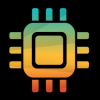One of the most transformative developments was the microprocessor. Introduced in the early 1970s, microprocessors such as the Intel 4004 (1971), Intel 8080 (1974), and Zilog Z80 (1976) made it possible to create smaller and more affordable computers. This innovation was a key driver behind the move towards personal computing.
Early computers in this period had very limited memory and storage. For example, the Altair 8800, released in 1975 and considered one of the first personal computers, initially came with just 256 bytes of memory. Storage was primarily handled using cassette tapes or floppy disks, which had capacities ranging from a few kilobytes to several megabytes. Input was mainly through keyboards and punch cards, while output was typically displayed on CRT monitors or printed on line printers. The user interfaces were primarily text-based until the development of more advanced graphical user interfaces (GUIs) in the early 1980s.
The Altair 8800, introduced in 1975, is often credited with sparking the personal computer revolution. Using the Intel 8080 microprocessor, it was initially sold as a kit and quickly gained popularity among hobbyists. This led to the creation of many early software companies, including Microsoft. Another notable computer was the Apple I, developed by Steve Wozniak and Steve Jobs in 1976. The Apple II, released in 1977, was one of the first highly successful mass-produced microcomputers, known for its color graphics and open architecture.
The Commodore PET, introduced in 1977, was Commodore’s first full-featured computer. It included a built-in keyboard, monitor, and data storage via cassette tapes, and it found widespread use in educational and business settings. The TRS-80, also released in 1977 by Tandy Corporation through Radio Shack stores, was another early personal computer that became popular due to its affordability and ease of use. In 1981, IBM entered the personal computer market with the IBM PC (Model 5150). Its use of off-the-shelf parts and the adoption of MS-DOS as its operating system set industry standards that influenced the development of personal computers for decades.
The impact of these early computers on society was profound. They democratized computing, making it accessible to small businesses, schools, and home users. This period also saw the rise of influential software companies and the beginning of widespread software development, which has led to the diverse software ecosystem we have today. The personal computer revolution also spurred interest in programming and computer science, leading to the establishment of computer literacy programs and the integration of computing into various fields such as science, engineering, and the arts.
In summary, the early computers of the 1970s and early 1980s were foundational to the development of modern computing. Their innovations in hardware, software, and accessibility paved the way for the ubiquitous and powerful personal computers we rely on today.
